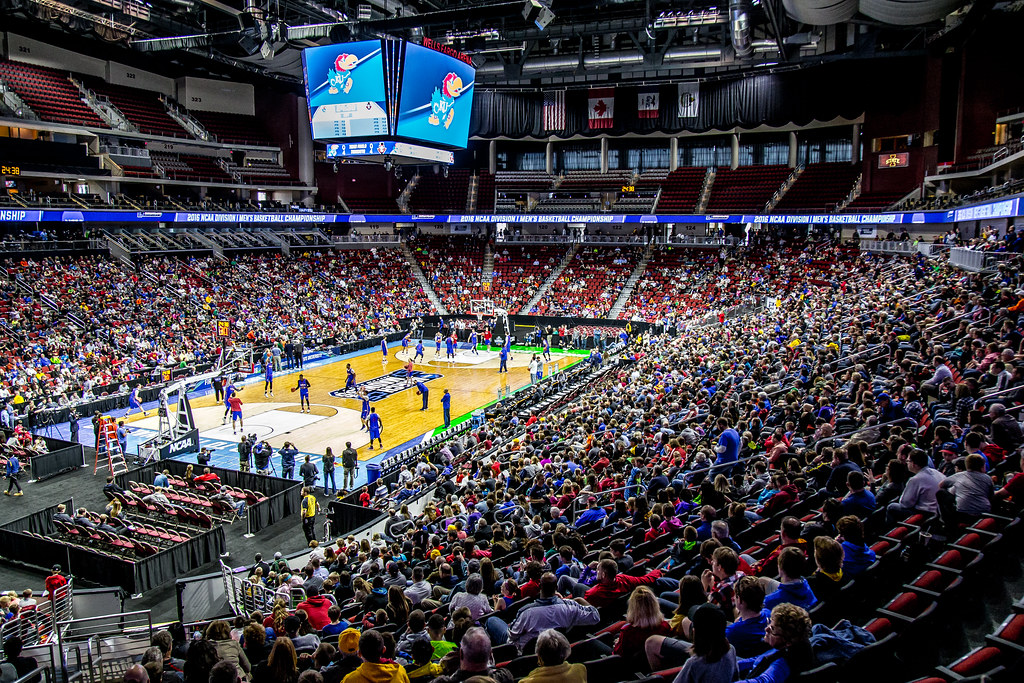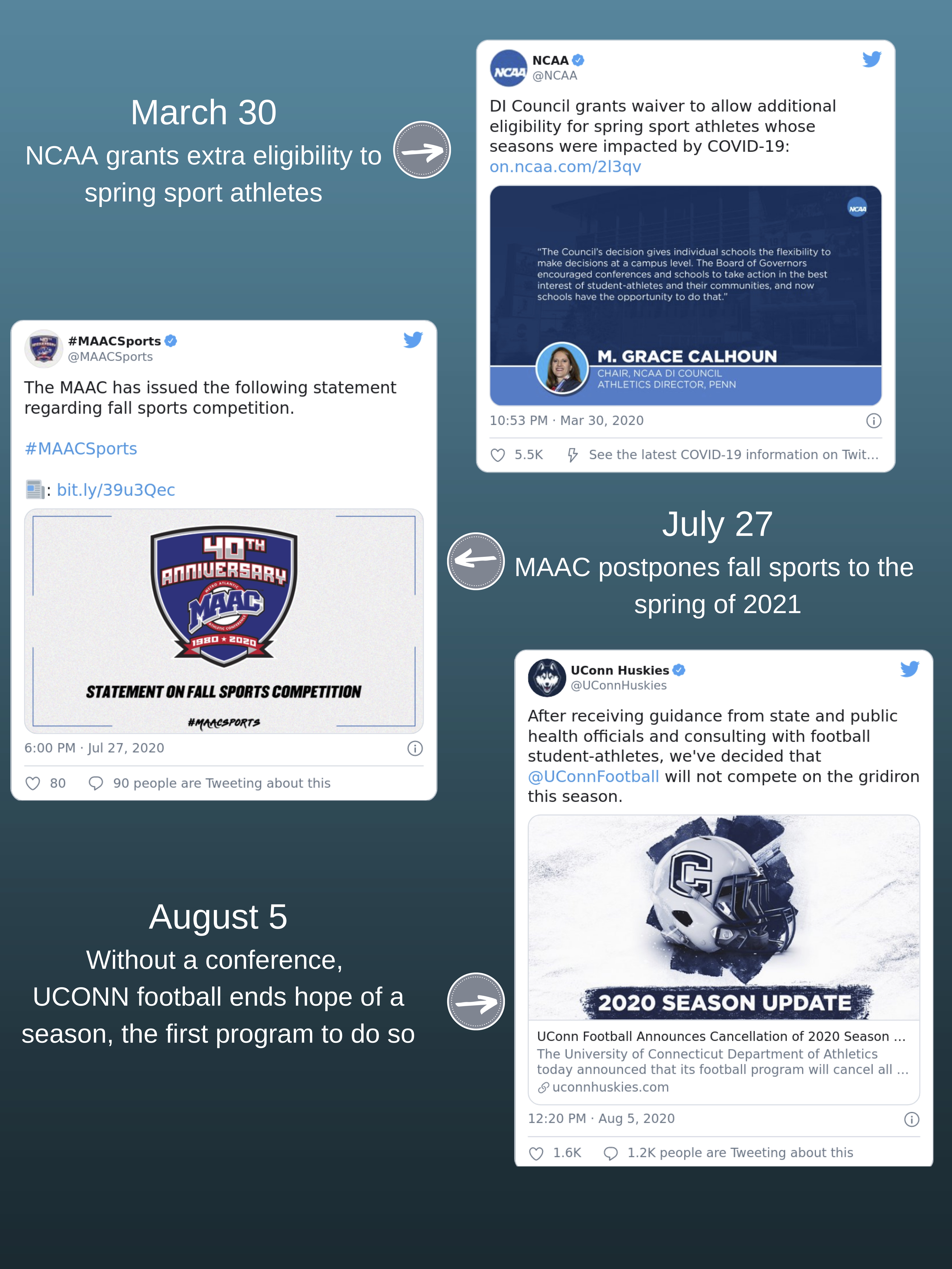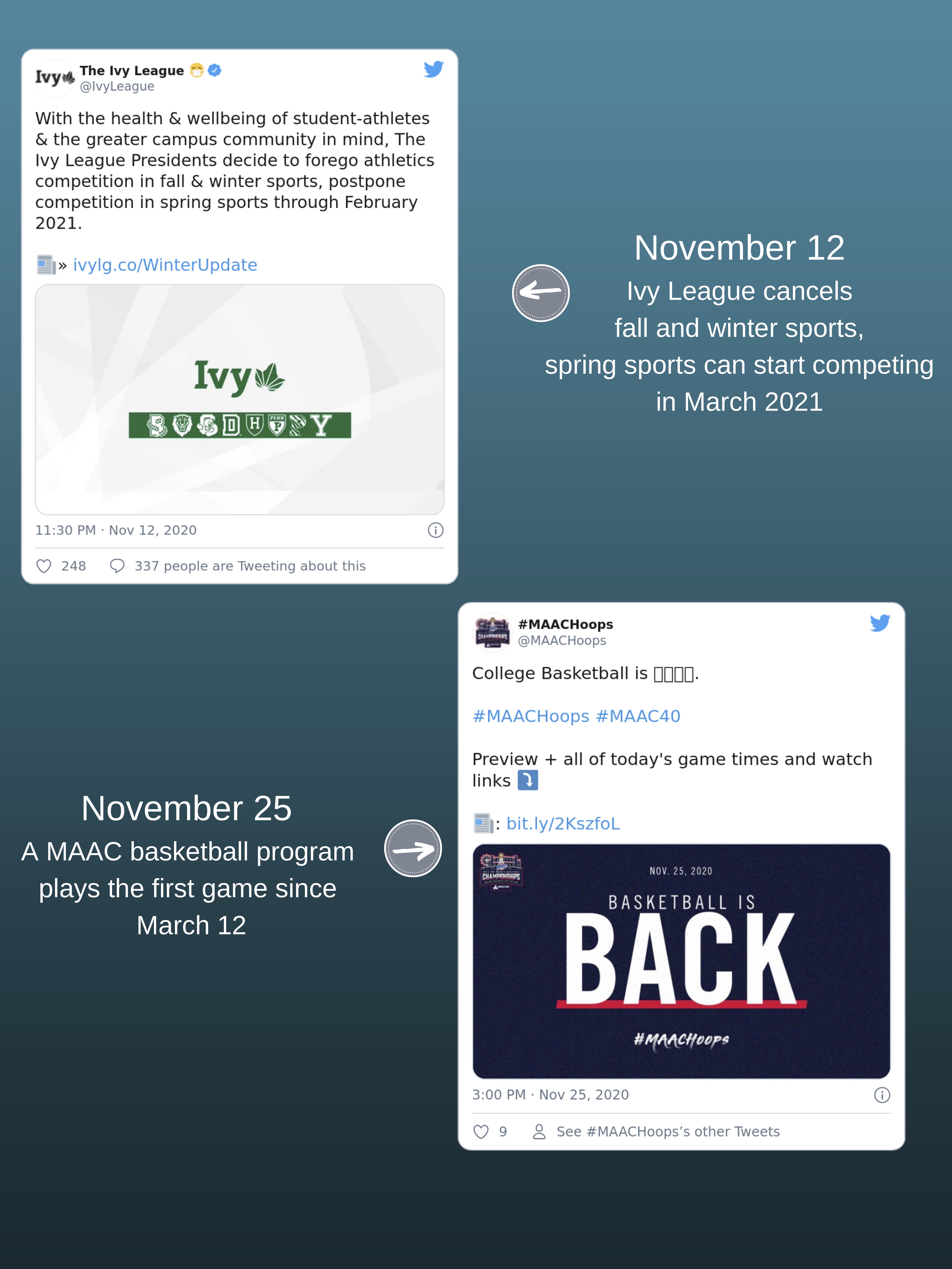And what will they do moving forward?
By Connor Ullathorne
The world came to a stand-still. Businesses shut down. All sporting events, from pickup basketball games at a local gym, to professional sports and NCAA’s March Madness, were canceled or postponed.
“Probably one of the eeriest days of my life,” Maggie Pruitt, an assistant director in athletic communications at Quinnipiac University, said. “I was in Atlantic City for basketball and was watching Iona and St. Peter’s play the night before we are supposed to play and saw the news about Rudy Gobert and the NBA canceling and my stomach kind of just dropped and I was like ‘this, this isn’t going to be good.’”
Those cancelations might not have hurt the professional leagues and teams too badly, but one of the largest moneymakers in America has suffered from the pandemic, collegiate athletics.

You would probably never hear college athletics and suffer in the same sentence before COVID-19. But athletic departments around the country have closed, shut down, cut teams and slashed budgets. The University of Connecticut struggled to balance the number of athletic teams representing them against their budget and has plans to cut sports from the university. A June 2020 report states the school is removing four sports at the end of the 2020-2021 season. The reduction is part of a plan to cut the athletic department’s institutional support down 25 percent by 2023.
The slightest decrease in a budget can throw a department into a spiral. Maybe they can’t offer a recruit a scholarship because they don’t have the budget. The university removed around five-million dollars from their scholarship expense from 2021, dropping from around $19 million in 2020 to $14 million in the upcoming fiscal year.
UConn was not the first athletic program to be impacted by COVID-19 in the United States. The schools in the Ivy League dealt the first blow to college sports back in March. The league canceled its mens and women’s basketball postseason tournament on March 10, and a day later, ended all hopes of any spring athletics at Ivy League schools, the first division in the NCAA to end college sports for the rest of the academic year.
“That’s a big thing to happen. I thought it was early, but in hindsight, they did the right thing, and they were the quickest to make the best decision.“
Maggie Pruitt
“I think everyone in the country saw that when it came to collegiate athletics,” Pruitt said. “I think in the end the Ivy League did set that precedent of being the first one, and probably the smartest ones.”
The smartest division has been one of the most influential divisions in the NCAA during COVID-19. Yale’s athletic department faculty and staff, including Tim Bennett, an assistant director in strategic communications, realize how much the division cares about the student-athletes who play to win their championships.
“I’ve worked in the Ivy League long enough to know that the decisions they make are always in the best interest of the students,” Bennett said. “In the days that came after it certainly became clear that it was the right decision.”
Quinnipiac University, while not in the Ivy League, still felt a massive shift by the cancelation of winter and spring sports back in March. It is a member of the Metro Atlantic Athletic Conference, and the MAAC postseason tournament for basketball was scheduled for March 10-13, but the tournament never went past the quarterfinals. Just like at universities around the country, all sports, for the remainder of the academic school year, were canceled.
“The safest thing for our student-athletes was to not play and then figured it was going to trickle down to the rest of our spring sports and hockey,” Pruitt said. “So, we saw like the other conferences canceling, and the MAAC was like the last one.”
The cancelation of March Madness and conference tournaments ended up costing the NCAA over 300-million dollars. The March Madness tournament generated over $1 billion in the past for collegiate athletics, made up from ticket sales, television rights and smaller sources of income such as donors. Since a portion of the money goes to the schools in the conferences, not to the NCAA, you can see how impactful losing the largest moneymaker event for the NCAA and the universities that compete within it really is.

“As a department, we’ve certainly been kept up to date on various financial matters,” Sam Rubin, an assistant director in strategic communications at Yale University. “But so far, we haven’t been told anything in terms of budgetary changes specifically related to COVID-19. I think we’ll kind of address that as we start phasing back into competition.”
Pruitt said the athletic department furloughed staff and that affected the entire department. “We know as a school where we’re recovering from something that has affected the whole country and the whole world,” Pruitt said. “So, we’re working together to try and figure out where we can save money, what’s the most efficient use of our time and resources and that affects every team, every sport and every operation.
Financially, like at Southern Connecticut State University, their total budget for the athletic department actually increased from 2020 to 2021, however, they compete at an NCAA DII level. According to Bennett, even though there might be some financial strain on the sports at Yale, he believes all teams will survive through the pandemic.
“I think our athletic director has been very good about looking into that matter and I think she’s made it clear that she does not want to, in any way, cancel any sports,” Bennett said. “I think with a strong alumni base and some fundraising, I think each of the sports feels confident moving forward. Obviously, it’s a challenge and they’re all working hard to come up with ways to raise money, but I don’t think any sports at Yale are in danger of being cut.”
The largest challenge for many of the athletic programs in the Connecticut region, and all over the country, is going to be starting back up and being able to finish their seasons in the spring, if sports are able to compete at that time. But the Ivy League schools won’t compete until it is safe to do so, and that all comes down to the discretion of the league’s presidents and the universities’ athletic directors.
“The presidents and athletic directors are paying very close attention to know what’s going on,” Rubin said. “Both in terms of the things like the number of cases and hospitalizations and deaths, but also the progress that’s being made with vaccines and treatments.”
Starting games back up in the Ivy League means moving players, equipment, coaches and staff members to other universities. Throw a pandemic in the mix, and the number one priority for athletic departments becomes figuring out how they can move their teams from point a to point b and keep them safe in the process of letting the student-athletes play the sports they love.
“Travel is so difficult,” Pruitt said. “Now, especially after the MAAC changed their schedule for basketball, they have a little bit of an easier road schedule when it comes to distance. But now that they’re playing on Fridays and Saturdays it really didn’t help us too much when it came to hotel rooms and stuff like that, which are your big money foundations of a team’s budget. I don’t know specifics on what teams cut but I know traveling and food are always the biggest concerns that we have to work on every year.”



